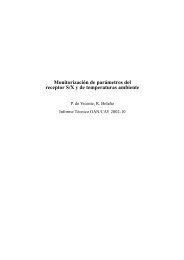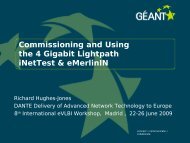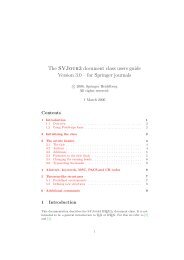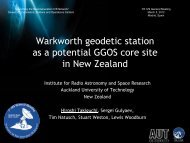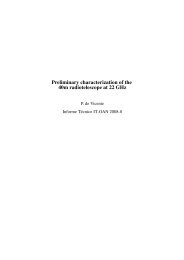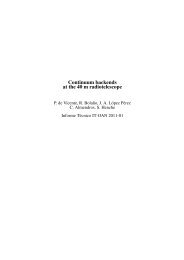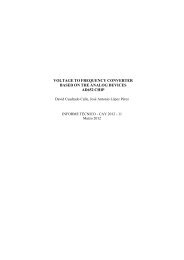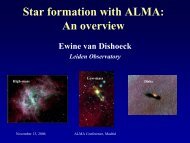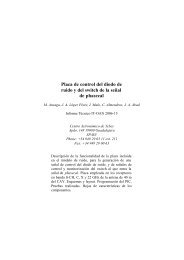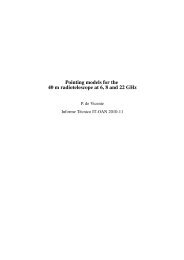Development of a web ephemeris server - Observatorio Astronómico ...
Development of a web ephemeris server - Observatorio Astronómico ...
Development of a web ephemeris server - Observatorio Astronómico ...
You also want an ePaper? Increase the reach of your titles
YUMPU automatically turns print PDFs into web optimized ePapers that Google loves.
<strong>Development</strong> <strong>of</strong> a <strong>web</strong> <strong>ephemeris</strong> <strong>server</strong><br />
T. Alonso Albi<br />
Informe Técnico IT-OAN 2010-13
1<br />
Change Record<br />
Version Date Author Remarks<br />
1.0 5-Ago-2010 T. Alonso Albi First version<br />
1.1 2-Oct-2010 T. Alonso Albi Revision
CONTENTS 2<br />
Contents<br />
1 Introduction 3<br />
1.1 The JPARSEC library . . . . . . . . . . . . . . . . . . . . . . . . . . . . . . . 3<br />
2 Implementation 7<br />
2.1 Design and structure . . . . . . . . . . . . . . . . . . . . . . . . . . . . . . . 7<br />
2.2 The HTML and Javascript code . . . . . . . . . . . . . . . . . . . . . . . . . . 9<br />
2.2.1 The sky and solar system simulator applet . . . . . . . . . . . . . . . . 9<br />
2.2.2 <strong>Development</strong>s in JPARSEC and dependency adaptation . . . . . . . . . 10<br />
2.2.3 Executing Java programs in a <strong>server</strong> . . . . . . . . . . . . . . . . . . . 11<br />
2.2.4 Returning <strong>web</strong> pages with charts . . . . . . . . . . . . . . . . . . . . . 12<br />
2.2.5 Geolocalization <strong>of</strong> the user and date selection . . . . . . . . . . . . . . 13<br />
3 Testing and installing 14<br />
3.1 Memory requirements in the applet . . . . . . . . . . . . . . . . . . . . . . . . 14<br />
3.2 Comparing results with the Anuario . . . . . . . . . . . . . . . . . . . . . . . 14<br />
3.3 Installing at OAN and IGN . . . . . . . . . . . . . . . . . . . . . . . . . . . . 14<br />
3.4 Updating data . . . . . . . . . . . . . . . . . . . . . . . . . . . . . . . . . . . 14<br />
3.5 Notes about precision, time span validity, and other limitations . . . . . . . . . 15
1 INTRODUCTION 3<br />
Abstract<br />
In this document the implementation <strong>of</strong> a <strong>web</strong> <strong>ephemeris</strong> <strong>server</strong> is described shortly. This<br />
<strong>server</strong> provides accurate astronomical <strong>ephemeris</strong> for solar system bodies, clear charts <strong>of</strong> the<br />
sky, and allows an interactive simulation <strong>of</strong> astronomical phenomena like eclipses. The <strong>server</strong><br />
is installed at the <strong>web</strong>site <strong>of</strong> the <strong>Observatorio</strong> Astronómico Nacional, and a link to it is provided<br />
at Instituto Geográfico Nacional (www.ign.es).<br />
1 Introduction<br />
I started developing astronomical programs at twelve using different programming languages<br />
like Basic, PowerBasic, or Fortran, among others. Without the great effort and time spent in<br />
these previous experiences it would have been impossible to consider the development <strong>of</strong> a<br />
<strong>web</strong> <strong>ephemeris</strong> <strong>server</strong>. Another point is the decision I took five years ago <strong>of</strong> developing all<br />
my work using the Java programming language. The idea was to reimplement everything I<br />
did in the previous 12 years in Java, and to connect all this astronomy with the developments<br />
in astrophysics during my thesis. The result is a consistent and well-documented library <strong>of</strong><br />
astronomical tools for research and general astronomical tasks.<br />
1.1 The JPARSEC library<br />
The JPARSEC library is currently structured in 33 packages, with 282 class files, and around<br />
217 000 lines <strong>of</strong> code. There are around 6000 lines <strong>of</strong> comments and 30 000 lines <strong>of</strong> documentation<br />
(JavaDoc). An additional 60 000 lines <strong>of</strong> code comes from support classes required to<br />
obtain ephemerides by means <strong>of</strong> ELP2000 and S. L. Moshier algorithms 1 . Most <strong>of</strong> the theories<br />
developed so far in celestial dynamics are implemented:<br />
• Planetary ephemerides: JPL ephemerides (DE200, DE403, DE405, DE406, DE413,<br />
DE414, with the required files for the time span between 1900 and 2100), the Steve L.<br />
Moshier fit to DE404, VSOP87 (complete and truncated versions), ELP2000, and Series96.<br />
The positions for other bodies (comets, asteroids, trans-Neptunian objects, space<br />
probes) can be obtained by solving their orbital elements, for elliptic, parabolic, or hyperbolic<br />
orbits.<br />
• Natural Satellites ephemerides: the 2007 Martian satellites theory (Mars), E2x3, E5,<br />
and L1 (Jupiter), Dourneau and TASS1.7 (Saturn), GUST86 (Uranus). The position <strong>of</strong><br />
Triton follows the Explanatory Suplement <strong>of</strong> the Astronomical Almanac. The position <strong>of</strong><br />
every moon (including dwarf satellites) can be obtained by solving the orbital elements<br />
provided by JPL.<br />
• Other ephemerides: stars (FK4, FK5, ICRS), artificial satellites, double stars.<br />
1 Another 20 000 lines <strong>of</strong> code (without considering in this case the HTML documentation) corresponds to<br />
end-user programs with GUIs, mainly astrophysical models.
1 INTRODUCTION 4<br />
The JPARSEC library includes a large number <strong>of</strong> other features that are summarized next.<br />
• Planetary ephemerides includes physical <strong>ephemeris</strong>, orientation <strong>of</strong> the disk following<br />
IAU2000 resolutions, subsolar points, any rise/set/transit times (civil, or nautical and<br />
astronomical twilights), constellation, and charts numbers for several books. For natural<br />
satellites information is given about the current status (transits, shadows, eclipses),<br />
whatever the theory being used. Mutual satellites phenomena are also calculated, with<br />
an estimate <strong>of</strong> the fraction <strong>of</strong> the disk occulted/eclipsed, and the effect in the apparent<br />
magnitude.<br />
• IAU resolutions are supported, and results are available for any output equinox, any kind<br />
<strong>of</strong> coordinates (geometric, astrometric, apparent), any analytical theory, different frames<br />
(J2000 or ICRS, FK4 supported on stars). Reduction from rectangular coordinates can be<br />
performed in multiple ways, using IAU1980 or IAU2000 methods for precession, nutation,<br />
and Greenwich mean sideral time, as well as other methods used during the years by<br />
DExxx <strong>ephemeris</strong> or IAU resolutions. IAU2006 and 2009 resolutions will be supported<br />
soon.<br />
• Almost fully updated, using the last recomendations for precession (Capitaine et al. 2003)<br />
mentioned by Hilton et al. 2006, and IAU resolutions about Pluto. Numerical integration<br />
theories updated, with the inclusion <strong>of</strong> JPL DE414 integration or the Martian <strong>ephemeris</strong><br />
theory by Lainey et al. 2007. Accuracy up to the milliarcsecond level in the reduced<br />
coordinates, limited only by the precision <strong>of</strong> the analytical theories.<br />
• Support for orbital elements from the Minor Planet Center, Celestrak, and also from the<br />
commercial program SkyMap. Orbital elements for planets available from the VSOP<br />
solution or calculable for any theory solving the orbit from a position and velocity vector.<br />
The user can easily port the format <strong>of</strong> orbital elements from any other program.<br />
• Any call to an <strong>ephemeris</strong> method has the same input/output parameters for an easy use<br />
or input change. Common input parameters are an EphemerisElement object (<strong>ephemeris</strong><br />
properties), and Ob<strong>server</strong>Element object (ob<strong>server</strong> position and atmospheric conditions,<br />
from a built-in database <strong>of</strong> more than 4000 cities or 1200 observatories), and a TimeElement<br />
object (calculation time, which can be set either in local time, universal time UT1<br />
or UTC, terrestrial time, and barycentric dynamical time). Calculation time can also be<br />
given in any calendar used or being in use.<br />
• Compatible with Virtual Observatory protocols. Vizier catalogs, Simbad resolving, CDS,<br />
UCD, ADS abstracts, SDSS queries, among others, are supported. Plastic interface can<br />
be used to send or receive data (Virtual Observatory tables) from other applications.<br />
• Very powerfull graphical capabilites, including the best planetary rendering method freely<br />
available. Simultaneous sky and planetary renderings are supported, with a large number<br />
<strong>of</strong> options and the possibility <strong>of</strong> showing stars up to 16th magnitude by means <strong>of</strong><br />
internet queries to UCAC3 catalogue (limiting magnitude <strong>of</strong> 10 without Internet connection).<br />
Complex charts are supported through a very simple interface to JFreeChart, that
1 INTRODUCTION 5<br />
allows to create s<strong>of</strong>isticate charts in a couple <strong>of</strong> lines <strong>of</strong> code. Charts can be exported to<br />
JPG, PNG, BMP, GIF, SVG, PDF, and EPS. At the same time, x-y dispersion charts can<br />
be exported to GILDAS package, by means <strong>of</strong> an automatic script generation algorithm.<br />
GILDAS can also be controlled in background using pyGILDAS, allowing any user to<br />
execute their own scripts from models. Contour charts in 2d can be created using SGT<br />
library. 3d charts are also supported with a similar interface to JMathPlot and VISAD.<br />
• A lot <strong>of</strong> methods for coordinates transformations, for general astronomical calculations,<br />
and for input/output tasks with the data contained in catalogs. Especially remarkable is<br />
the HTML and LATEX support, that allows to export query results or tables in these formats,<br />
or even to create full pdf documents with easy. Available math operations include<br />
numerical integration, derivatives, root search, ponderation, interpolation, function fitting,<br />
and dynamical evaluation <strong>of</strong> expressions. A unit conversion utility is also available.<br />
Complex numbers and matrix operations (solving systems, eigenvalues) are supported.<br />
• Astrophysical models available that can be used for scientific research. Among them an<br />
LTE/LVG gas radiative transfer model with 3d visualization <strong>of</strong> cubes, Kurucz 1992 LTE<br />
models for stellar atmospheres, a complete model for dust opacity based on Draine (using<br />
a Mie scattering code), or rotational diagrams. JPL and COLOGNE databases <strong>of</strong> molecular<br />
spectroscopy are integrated in the package, with no need <strong>of</strong> Internet connection to<br />
use them. The circumstellar disks model <strong>of</strong> Dullemond is also available, and is integrated<br />
with Virtual Observatory tools to provide an almost automatic SED fitting tool, taking the<br />
photometry automatically from Vizier catalogs and the stellar properties from Siess evolutionary<br />
tracks for pre-main sequence stars. A Java version <strong>of</strong> RADEX is also provided,<br />
including all the molecules/atoms currently available.<br />
• Many more advanced operations very useful for developing applications, like a complete<br />
data model system that allows to perform error calculations by applying maths to physical<br />
measurements or unit transformations, technical calculations for single dishes (30m) and<br />
interferometers (PdBI), calculations with astronomical instruments (telescopes, oculars,<br />
CCDs), support to read and write spectra and cubes directly in the .30m and .lmv formats<br />
and .fits (as an output from a model for example), advanced net functions (servlets, mails,<br />
ftp access), or development <strong>of</strong> dialogs with integrated functions in buttons or lists.<br />
• Automatic updates supported for any information used in the package that is subject to<br />
change: orbital elements <strong>of</strong> minor bodies, the list <strong>of</strong> observatories, Earth orientation parameters,<br />
solar spots database, and JPL and COLOGNE databases.<br />
• It is written in Java 1.6 (most features compatible with Java 1.4), so it can be used in any<br />
java-capable device.<br />
The library is the core <strong>of</strong> all the work I have done in the last few years, and it cannot be described<br />
deeply in this document. Source code if freely distributed under the terms <strong>of</strong> the GPL license,<br />
and is available at http://conga.oan.es/%7Ealonso/doku.phpid=jparsec. First years were<br />
mainly dedicated to development, but progresively most <strong>of</strong> the features have come to production<br />
phase, so the development <strong>of</strong> an <strong>ephemeris</strong> <strong>server</strong> (as other projects like astrophysical models)<br />
have become feasible.
1 INTRODUCTION 6<br />
Figure 1: An example <strong>of</strong> the planetary rendering capabilities <strong>of</strong> the JPARSEC library, with the<br />
apparent vision <strong>of</strong> the planets during year 1000 B.C. This chart has been generated directly from<br />
the <strong>web</strong> <strong>ephemeris</strong> <strong>server</strong>, and a similar one will be included in the next editions <strong>of</strong> the Anuario.
2 IMPLEMENTATION 7<br />
2 Implementation<br />
The <strong>web</strong> <strong>ephemeris</strong> <strong>server</strong> was developed in June, 2010. Ephemeris calculations and chart<br />
generation comes from previous works, whereas the new work is mainly the <strong>web</strong> interface and<br />
some Java development to return the results as a <strong>web</strong> page. In this section I will analize how<br />
the <strong>server</strong> was implemented and the different decisions taken during its development.<br />
2.1 Design and structure<br />
The <strong>web</strong> <strong>ephemeris</strong> <strong>server</strong> was initially designed to be installed at the <strong>web</strong>site <strong>of</strong> the Instituto<br />
Geográfico Nacional (IGN), so the structure <strong>of</strong> this <strong>web</strong>site was inevitably taken as rule by<br />
copying some <strong>of</strong> the files <strong>of</strong> the <strong>server</strong> before starting writting HTML code.<br />
The design <strong>of</strong> the <strong>ephemeris</strong> <strong>server</strong> itself was done after listing all services and different kind<br />
<strong>of</strong> calculations that it should implement. As with other services implemented at IGN, a short top<br />
menu composed by three main options was included. When clicked, these options were spread<br />
out (or spread in if they were clicked again) to show the different sections. The design <strong>of</strong> the<br />
<strong>server</strong> gave preference to interactive visualization <strong>of</strong> the sky and ability to retrieve in one click a<br />
large amount <strong>of</strong> information and astronomical events. The typical option to retrieve <strong>ephemeris</strong><br />
by means <strong>of</strong> a form, which is usually the only option available in other <strong>ephemeris</strong> <strong>server</strong>s, was<br />
also present, but it was a secondary possibility.<br />
• Planetarium: the first option gave access to an interactive program to simulate the sky.<br />
By taking advantage <strong>of</strong> latest Java technology an advanced simulation <strong>of</strong> the sky and the<br />
planets was shown, with great freedom and performance. This program was also used<br />
to simulate eclipses and other events. A link was given to download the applet to use it<br />
without Internet connection.<br />
• Astronomical events: this second option showed a page with a chart <strong>of</strong> the sky towards<br />
south, the date in different calendars and time scales, the value <strong>of</strong> some astronomical<br />
parameters, the eclipses during this year and the next, moon phases, equinoxes and solstices,<br />
and planetary phenomena (opositions or conjunctions, charts with apparent sight<br />
and trajectories, and orbital elements, among others). For some <strong>of</strong> the previous phenomena<br />
some links were provided to simulate them using the applet, and also some other<br />
links were available at the bottom <strong>of</strong> the page to show detailed ephemerides using the<br />
third option. The page was generated for Madrid and for the current date, but a little form<br />
below it allowed to generate it for any other instant, and for Madrid or Tenerife.<br />
• Astronomical <strong>ephemeris</strong>: this option allowed to query an specific calculation by filling<br />
a simple form with the ob<strong>server</strong> position, the calculation time (a date or interval <strong>of</strong> dates),<br />
and the object name. Some special features like the geolocalization <strong>of</strong> the user to set its<br />
geographical position, or the calendar component to introduce dates with easy were included.<br />
Ephemeris were available for planets, the Sun or Moon, natural satellites, comets,<br />
asteroids, trans-Neptunian objects, dwarf planets, artificial satellites, or space probes.<br />
After some testing me and other astronomers realized rather quickly that the second option<br />
(sky events) should be the only one. It already contained links to simulate the sky, so the first
2 IMPLEMENTATION 8<br />
option was covered, and it seemed natural to add at the end another link to a separate form to<br />
retrieve ephemerides. The main page is now called servidorEfem.php and contains the calls<br />
from PHP to Java to directly retrieve the main frame. The separate page for the form itself<br />
was improved by automatically retrieving the name <strong>of</strong> the closest city and its elevation when<br />
clicking on a Google map. One limitation <strong>of</strong> having the form in another page is the impossibility<br />
<strong>of</strong> having the url <strong>of</strong> the <strong>server</strong> completely hidden, but now the idea is to migrate the <strong>ephemeris</strong><br />
<strong>server</strong> from conga <strong>server</strong> to the <strong>server</strong> where the main OAN pages are located. IGN could load<br />
this page inside an iframe object so that everything would be quite hidden.<br />
Besides a lot <strong>of</strong> minor esthetic improvements and simplifications (for example, the FreeHEP<br />
library was discarded), two major computations were added: the transits <strong>of</strong> Mercury and Venus<br />
through the disk <strong>of</strong> the Sun, and the events for the satellites <strong>of</strong> Jupiter and Saturn. In the last<br />
case the implementation includes both the events caused by the mother planet (transits, shadow<br />
transits, eclipses, or occultations), and mutual events between two satellites (occultation/eclipse<br />
<strong>of</strong> one satellite due to another). Both cases can be simulated with the applet straightforward.<br />
Another service was developed to automatically update the dependencies by downloading<br />
and packing certain files, so the <strong>ephemeris</strong> <strong>server</strong> can be updated anytime. Since this service<br />
didn’t work online due to a security manager issue (and to do this is indeed not secure), the<br />
service was replaced by a script called update.sh. However, there are some limitations in this<br />
process (the longitude <strong>of</strong> the Great Red Spot in Jupiter, and the leap seconds and TT minus UT1<br />
difference), so each year or two years three files in sky.jar and time.jar will require an update by<br />
hand. Time data can be updated using the Anuario, whereas the Great Red Spot longitude can<br />
be updated from http://jupos.privat.t-online.de/rGrs.htm.<br />
I developed two versions <strong>of</strong> the <strong>server</strong> with different levels <strong>of</strong> precision and performance.<br />
The one to be implemented will depend on the speed <strong>of</strong> the <strong>server</strong> and other considerations.<br />
The fastest version uses Moshier algorithms always, both in the <strong>ephemeris</strong> <strong>server</strong> itself and the<br />
applet. The startup time for the applet is between 2-3 seconds in Firefox and 1 second or less<br />
in Konqueror (since it doesn’t use a security manager), and the time required to load the main<br />
page for the <strong>ephemeris</strong> <strong>server</strong> is around 12 seconds. In the version with better precision the<br />
ephemerides are calculated using JPL DE406 between 1900 and 2100, with a precision in the<br />
milliarcsecond level 2 , after that interval the Moshier fit to DE404 is used. This gives a maximum<br />
error <strong>of</strong> about 2 arcseconds for planets in year 1000 B.C. For the Moon the ELP2000 theory is<br />
always used outside that interval. When a set <strong>of</strong> ephemerides is to be retrieved in certain time<br />
span (resulting in a table with more than one row), the algorithm is automatically changed to<br />
Moshier to obtain a decent level <strong>of</strong> performance. However, the performance in this version is<br />
relatively poor, main page loads after 24 seconds and the applet needs 12 seconds to start. In<br />
addition, in this version the applet needs to download 30 MB <strong>of</strong> data instead <strong>of</strong> 20.<br />
These speed results are an important limitation, so the current version to be implemented is<br />
the fastest one.<br />
2 JPL DE406 is used since it is the algorithm currently adopted by the IAU, although the differences with later<br />
versions like DE414/18/21 exceeds the 0.01" level. In addition, this level <strong>of</strong> precision is difficult to test through<br />
this <strong>server</strong> and against others, without using the JPARSEC library. For example, the IMCCE uses an old method<br />
(IAU 1980 set <strong>of</strong> algorithms) to reduce coordinates, which are supported by the JPARSEC library so they can<br />
be reproduced to the milliarcsecond, but in this work the latest algorithms recently adopted by the IAU are used<br />
instead. JPL Horizons uses slightly more updated algorithms, but gives less digits in the results.
2 IMPLEMENTATION 9<br />
2.2 The HTML and Javascript code<br />
The main page is called servidorEfem.php. It contains the PHP code to call Java programs<br />
from the <strong>server</strong>, and a little form that allows to generate the main page for different dates and<br />
locations. The main page is generated by a Java service that calculates, among other data, the<br />
date in different calendars, some astronomical parameters, lunar phases, eclipses, and includes<br />
some links to retrieve additional tables and charts using other services.<br />
This main page also includes links to simulate the astronomical events using an applet. The<br />
applet is loaded using the file Firmamento.html, that contains the necessary Javascript code to<br />
read parameters for the applet in case they are provided.<br />
At the end <strong>of</strong> the main page a link is provided to another page to fill in a form to query<br />
ephemerides, called formulario.php. It has three sections: the input <strong>of</strong> the geographical position<br />
to refer the <strong>ephemeris</strong> to, the input <strong>of</strong> the date and time or interval <strong>of</strong> dates, and the object<br />
name to calculate <strong>ephemeris</strong>. This file uses PHP code to obtain the current user IP, and then<br />
a Java program from JPARSEC library is executed to obtain the translation <strong>of</strong> this IP to its<br />
geographical position, so that the first section <strong>of</strong> the form is filled automatically. The second<br />
section is filled with the local time <strong>of</strong> client’s computer.<br />
2.2.1 The sky and solar system simulator applet<br />
To show the sky and provide the user with an adequate tool to simulate astronomical phenomena<br />
dynamically and interactivelly an advanced applet was developed. This applet is based on a<br />
planetarium s<strong>of</strong>tware currently in development, and implements latest improvements in sky and<br />
planetary rendering achieved in work done as previous contributions to the Anuario.<br />
The program allows to select a country and a city in two lists, and the date and time in local<br />
time. The projection can be selected between stereographical, cylindrical, polar, and spherical.<br />
The coordinate system between equatorial, ecliptic, galactic, and horizontal. The object to focus<br />
can be selected between the Sun, the Moon, the planets, and the constellations. The field <strong>of</strong><br />
view is selected using a given telescope and ocular from two lists. There are some visualization<br />
options to show planets with textures, with north/south and rotation axes, and with all satellites.<br />
In the last case the specific algorithm to show satellites accuratelly for each planet in substituted<br />
by a general algorithm that uses orbital elements from JPL, with less precision but more number<br />
<strong>of</strong> satellites. There are also some buttons to accept the changes introduced and to calculate the<br />
new chart, to search for a given object, or to export the chart to a file. Allowed formats are the<br />
classical ones like PNG or JPG (vector graphic formats like EPS or SVG was supported using<br />
FreeHEP library, but later discarded to reduce the amount <strong>of</strong> data to be downloaded). The date<br />
is selectable between years -1350 (1350 B.C.) and year 3000. Year zero is not accepted. The<br />
algorithms selected are the best possible combination in terms <strong>of</strong> precision and performance,<br />
and generally the most up-to-date. This and other information is provided in the <strong>ephemeris</strong><br />
<strong>server</strong>, below the applet itself, and can be seen by dragging downwards the bar on the right.<br />
There are more selectable options in the input parameters <strong>of</strong> the applet, that can be modified<br />
by editing the HTML file Firmamento.html that launches it. This can be done locally<br />
by downloading the applet, or remotelly by including in the browser some parameters like<br />
"loc=Madrid&coordSystem=1". The date and time, country and location, telescope and ocular,<br />
central object, projection, and coordinate system can be modified in this way (using
2 IMPLEMENTATION 10<br />
Figure 2: Screenshot <strong>of</strong> the English version <strong>of</strong> the applet. The <strong>server</strong> is implemented in Spanish.<br />
Javascript) to properly show different kind <strong>of</strong> astronomical events. Another option is to change<br />
the color mode to show the applet with black or white background, or even in anaglyph mode<br />
to show depth levels (distances to the stars). This feature requires 3d glasses (either red-green<br />
or cyan-red ones). In the first option <strong>of</strong> the astronomical events section, just below the chart<br />
showing the current sky towards south, some links are provided to simulate the sky in any color<br />
mode.<br />
These parameters provide the necesary flexibility to simulate different kind <strong>of</strong> astronomical<br />
events.<br />
2.2.2 <strong>Development</strong>s in JPARSEC and dependency adaptation<br />
Most <strong>of</strong> the development was done in the last four years for other purposes, but some was<br />
required to develope the <strong>server</strong>. This was the case <strong>of</strong> planetary events (Lunar phases, opositions<br />
and conjunctions, perihelion and aphelion, equinoxes and solstices, and eclipses), which use the<br />
Astronomical Algorithms book by Jean Meeus. The oposition, conjunction, perigee, apogee,<br />
perihelion, and aphelion events were corrected using the Moshier ephemerides (a fit to JPL<br />
DE404), and the eclipses implementation by Jean Meeus was used instead <strong>of</strong> the one previously<br />
present in the library due to its better performance.<br />
The files that implements the <strong>server</strong> include the main dependencies <strong>of</strong> the JPARSEC library,<br />
and are the same files as those for the applet. These dependencies includes .jar files to read<br />
orbital elements, earth orientation parameters and time data, telescopes and oculars, Moshier
2 IMPLEMENTATION 11<br />
<strong>ephemeris</strong> files, and to show sky catalogs, textures, icons and images, or solar spots. All these<br />
files are the same as those distributed within the JPARSEC library, except the textures file. The<br />
resolution <strong>of</strong> the textures was reduced to improve download time and performance, without<br />
a noticeable lost <strong>of</strong> image quality. Also, most files can be updated automatically using the<br />
JPARSEC library.<br />
The first version <strong>of</strong> the <strong>ephemeris</strong> <strong>server</strong> also includes the possibility <strong>of</strong> showing detailed<br />
astronomical events for every day, like transits or eclipses <strong>of</strong> natural satellites or Venus and<br />
Mercury transits on the Sun disk. Other events like conjunctions between different kind <strong>of</strong><br />
astronomical objects were discarded due to a lack <strong>of</strong> time.<br />
The <strong>web</strong> services are implemented by the classes contained in <strong>web</strong>Services.jar. No source<br />
code is provided to reduce the amount <strong>of</strong> data downloaded, but everything is available at<br />
http://conga.oan.es/%7Ealonso/doku.phpid=jparsec.<br />
2.2.3 Executing Java programs in a <strong>server</strong><br />
There are different approachs to execute Java programs in a <strong>server</strong>, but the best way in terms <strong>of</strong><br />
performance is to use servlets. This approach introduces some complexity in the configuration<br />
<strong>of</strong> the <strong>server</strong>, but the main limitation is that to update the programs the <strong>server</strong> must be reinitialized.<br />
Another problem is that servlets (as the applets) must be created programmatically and<br />
specifically for each purpose, and this introduces some extra work in the development.<br />
The approach considered in the <strong>ephemeris</strong> <strong>server</strong> is to execute Java programs by calling<br />
them through command-line by means <strong>of</strong> a PHP program. The output from the console is used<br />
to create the HTML output to be sent to the user. This approach is more simple in terms <strong>of</strong><br />
<strong>server</strong> configuration and Java development, but less efficient since each execution requires to<br />
run a new instance <strong>of</strong> the Java Virtual Machine, that consumes more resources and processing<br />
time. Anyway, the <strong>server</strong> is expected to be enough robust to account for this, and the number<br />
<strong>of</strong> queries to be received is expected to be small enough. The <strong>ephemeris</strong> <strong>server</strong> only requires to<br />
have PHP enabled and a Java Runtime Environment version 1.6 installed. In addition, the latest<br />
version <strong>of</strong> Java has important improvements in terms <strong>of</strong> memory consumption and startup time.<br />
Anyway, it is not discarded to implement a new version using servlets in a future.<br />
A example <strong>of</strong> a PHP script used to execute Java programs is shown below. The PHP script<br />
receives a request as http://...phpcommand=someCommand, where the command is in this case<br />
the name <strong>of</strong> the class to be executed and the parameters to pass to that program (separated by<br />
_, which is later transformed to blank spaces). For each specific query (for a chart or an HTML<br />
page to show a table with <strong>ephemeris</strong> results) the PHP used is slightly different, including inside<br />
it the class to be executed, in order to avoid that a given user could execute other programs<br />
included in the library from the <strong>server</strong>.<br />
2 IMPLEMENTATION 12<br />
graphicsio-ps-2.1.1.jar:/home/alonso/public_html/servidorEfem/lib/freehep-graphicsio-svg-2.1.1.jar:/home/al<br />
io-2.0.2.jar:/home/alonso/public_html/servidorEfem/lib/freehep-swing-2.0.3.jar:/home/alonso/public_html/se<br />
util-2.0.2.jar:/home/alonso/public_html/servidorEfem/lib/freehep-xml-2.1.1.jar:/home/alonso/public_html/ser<br />
$command";<br />
$output = array();<br />
exec($command, $output);<br />
foreach ($output as $key => $value)<br />
echo "$value \n";<br />
><br />
So the PHP program uses Java 1.6 to execute a program from the library, including in the<br />
classpath everything that the program could require, and returns the output <strong>of</strong> the program to the<br />
user. Since the Java program is executed directly from command-line, there is no graphic environment<br />
in this case, i.e. the program is executed in headless mode (-Djava.awt.headless=true).<br />
This means that the program in not capable <strong>of</strong> showing frames or windows on the screen (in the<br />
<strong>server</strong>), which is an additional reasonable condition. This limitation also imposes some minor<br />
conditions in the code when generating charts in headless mode.<br />
2.2.4 Returning <strong>web</strong> pages with charts<br />
The HTML output is created using the class jparsec.io.HTMLReport. A report generated with<br />
this class has some advantanges. For example the class hides the complexity <strong>of</strong> creating HTML<br />
output with links and tables, saving time. Another advantage if that the constructor <strong>of</strong> the<br />
HTMLReport object can be directly changed by a LATEXReport object, resulting in a LATEX<br />
output with no additional modifications in the code most <strong>of</strong> the times.<br />
However, to return charts in an efficient way is slightly more complicated. The usual approach<br />
would be to write the image in some path <strong>of</strong> the <strong>server</strong>, and to return the image including<br />
that path in the SRC property <strong>of</strong> the HTML tag. This approach is very inefficient since<br />
it requires to manage in some way the images created and to eliminate them from the <strong>server</strong><br />
at some time. The approach considered in the <strong>ephemeris</strong> <strong>server</strong> is to include the image itself<br />
inside the SRC property, using a technique called base 64 encoding. This technique, which is<br />
something standard in HTML, encodes the image and transforms it into a set <strong>of</strong> characters that<br />
represents it. As with most standards, Micros<strong>of</strong>t Internet Explorer does not support it, at least<br />
before its version 7. With other browsers like Mozilla Firefox or Opera there is no problem to<br />
show the images. To write the image in this format first it has to be encoded in base 64 and written<br />
inside the SRC property, including as a prefix "data:image/png;base64," for a PNG image.<br />
This technique increments the size <strong>of</strong> the HTML output by about 15% (usually more for images<br />
in PNG format as those used in the <strong>server</strong>, and less for JPG ones), but has important advantages.<br />
The base 64 encoding/decoding functions have been taken from Christian d’Heureuse 3 , and are<br />
found inside the JPARSEC library (jparsec.jar) at jparsec.io.image.Base64Coder.<br />
3 See http://www.source-code.biz/base64coder/java/.
2 IMPLEMENTATION 13<br />
Figure 3: An example chart with the sky in Madrid on March 15, 2011, 19:15 UTC, looking<br />
towards south.<br />
2.2.5 Geolocalization <strong>of</strong> the user and date selection<br />
The geolocalization is done by the PHP script geolocalization.php, which is called within the<br />
form from formulario.php. It gets the client IP address (or the IP <strong>of</strong> the Internet provider if<br />
client’s IP is unknown) and then calls jparsec.ob<strong>server</strong>.Ob<strong>server</strong>Element giving as a parameter<br />
the IP. The program in that Java class calls the free IP geolocalization service called IPInfoDB 4 ,<br />
giving as a result several lines <strong>of</strong> text with the location, the latitude and longitude, and the time<br />
zone. Later these data is used by means <strong>of</strong> Javascript to set the fields <strong>of</strong> the form accordingly.<br />
The formulario.php file includes a call to Google Maps API to show the current geographical<br />
position <strong>of</strong> the user in a map. The map can be dragged and zoomed to search for a given<br />
location. A double clic on any point <strong>of</strong> the map will set the coordinates <strong>of</strong> that position in the<br />
corresponding fields. The location name and height above sea level will be set to the closest city<br />
available in a database with more than 4000 cities around the world (and another 8000 locations<br />
only for Spain).<br />
To introduce dates in the form a free Javascript calendar component called Tigra Calendar 5<br />
is used. The component is very simple to use and is directly integrated in formulario.php.<br />
4 See http://ipinfodb.com/.<br />
5 See http://www.s<strong>of</strong>tcomplex.com/products/tigra_calendar/.
3 TESTING AND INSTALLING 14<br />
3 Testing and installing<br />
Testing phase took place in July, 2010. During two weeks some corrections were done in certain<br />
areas, and after some major improvements were added as a results <strong>of</strong> my own testing and some<br />
comments given by other astronomers. Installation came in October, 2010.<br />
3.1 Memory requirements in the applet<br />
The applet requires 300 MB <strong>of</strong> RAM to work. In recent installations <strong>of</strong> the Mozilla browser and<br />
the Java plugin this requirement is not a problem, since the newer Java plugin included in JRE<br />
1.6u10+ allows to increase the memory <strong>of</strong> the applets by including some parameters in the <strong>web</strong><br />
page that launches it. But in other cases the Java plugin should be manually configured to allow<br />
applets to use a large amount <strong>of</strong> memory. In Linux an attempt to solve this problem was done<br />
by updating both the browser and tha Java installation under Ubuntu Intrepid, without success,<br />
whereas an updated Debian Lenny worked fine without any manual configuration.<br />
This configuration process is explained in the section <strong>of</strong> the Firmamento.html file that describes<br />
the applet. Basically it is necessary to launch the Sun Java 6 Plugin Control Panel, and<br />
under the Java tag, click on the first upper button and add "-Xms300m -Xmx400m" to the (usually<br />
empty) field called parameters <strong>of</strong> the runtime environment. After accepting and applying<br />
the browser should be reinitialized.<br />
3.2 Comparing results with the Anuario<br />
No significative differences were found when checking results with those from the Anuario.<br />
The maximum difference in the eclipses was found to be 1 minute, which is the maximum<br />
expected difference since both results are rounded to the nearest minute.<br />
3.3 Installing at OAN and IGN<br />
The installation <strong>of</strong> the <strong>ephemeris</strong> <strong>server</strong> was done in October, 2010. The files were installed<br />
at one <strong>of</strong> the OAN <strong>server</strong>s at Yebes, and the machine mapped to be accesible from the url<br />
http://www.oan.es/publico/servidorEfem/. The main page servidorEfem.php was renamed to<br />
index.php. At IGN a page was included with a link to this page.<br />
3.4 Updating data<br />
The update.sh script located at /lib subdirectory should be executed at regular intervals to maintain<br />
sky.jar, eop.jar, sunspot.jar, and orbital_elements.jar files updated. Before doing that it is<br />
recommended to backup those files. After this process the <strong>ephemeris</strong> <strong>server</strong> should be tested<br />
(specially the applet that simulates the sky) to check that everything is correct. The script will<br />
also inform if the files inside time.jar or the longitude <strong>of</strong> the Great Red Spot in Jupiter (orbital_elements.jar)<br />
should be updated. To update time.jar the Anuario can be used, whereas the<br />
GRS longitude can be updated from http://jupos.privat.t-online.de/rGrs.htm. The .jar files are
3 TESTING AND INSTALLING 15<br />
standard .zip compressed files, that can be uncompressed using Ark for example (you may need<br />
to change the extension to .zip previously).<br />
A complete update requires a few minutes and it is enough to do it once a year.<br />
3.5 Notes about precision, time span validity, and other limitations<br />
There are a few limitations in the precision <strong>of</strong> the results.<br />
• The calculation <strong>of</strong> the dates in different calendars follows Calendrical Calculations, second<br />
edition, by N. Dershowitz and E.M. Reingold. The second edition is known to still<br />
contain some errors, whereas in the third edition (2008) they are mostly corrected, but the<br />
library is not updated. Before October 15, 1582 the program assumes that the input date<br />
is in the Julian calendar, although days between 5 and 14 <strong>of</strong> that month and year will give<br />
error since these dates were inexistent.<br />
• The date given in UT1 time scale will be equal to that in UTC for dates after the last<br />
update <strong>of</strong> the Earth orientation parameters (file eop.jar) in the <strong>server</strong>. This date is currently<br />
August, 1, 2010.<br />
• The main page can be generated for any location and country in the database (4000 cities<br />
around the world and 8000 locations for Spain). A little form at the bottom allows to<br />
generate the main page for Madrid, Tenerife, and any other location (providing its name).<br />
When there are more than one location with the same name the <strong>server</strong> gives preference to<br />
the Spanish one, if there’s any. The applet uses a reduced list <strong>of</strong> locations for Spain, so<br />
only the main capitals will be recognized, although the effects <strong>of</strong> a wrong location in the<br />
sky simulation is negligible and another location closer to the user can be selected from<br />
the applet with easy.<br />
• The instants <strong>of</strong> Lunar phases and eclipses follows the Astronomical Algorithms <strong>of</strong> Jean<br />
Meeus, which uses a fit to ELP2000 Lunar theory, which is itself a fit to JPL DE200<br />
<strong>ephemeris</strong>. The implementation uses all terms, so this could result in negligible errors<br />
for lunar phases and errors <strong>of</strong> about 1 minute for eclipses, when comparing results with<br />
the entire ELP2000 theory. This is not a big concern since the results <strong>of</strong> the <strong>server</strong> are<br />
rounded to the nearest minute. In addition, the original ELP2000 theory is known to be inaccurate<br />
due to a wrong value <strong>of</strong> the secular acceleration <strong>of</strong> the Moon used in JPL DE200<br />
<strong>ephemeris</strong>, but this problem can be fixed easily. Once corrected, ELP2000 <strong>ephemeris</strong> can<br />
match JPL DE405 up to the arcsecond level in year 1000 B.C. 6 .<br />
• When a set <strong>of</strong> ephemerides is to be retrieved in certain time span (resulting in a table with<br />
more than one row), the algorithm is automatically changed to Moshier to obtain a decent<br />
level <strong>of</strong> performance.<br />
6 In fact, the Five Millennium Canon <strong>of</strong> Solar/Lunar Eclipses by Fred Spenak shows a difference <strong>of</strong> only 30<br />
seconds for the eclipses around year 1000 B.C. Anyway, the projection <strong>of</strong> the Moon position to ancient times is<br />
difficult to derive due to uncertainties in the Moon secular acceleration, and its value is not necessarily constant.
3 TESTING AND INSTALLING 16<br />
• The version to be implemented will be the one with better performance. Not only in this<br />
case the precision if far enough, but also the JPL DE406 <strong>ephemeris</strong> is becoming outdated<br />
compared to latest JPL integration theories like DE414 (included in JPARSEC), or DE418<br />
or DE421. The differences in the positions between these latest integrations and DE406<br />
is in the 0.01 arcsecond level, which is quite above the level <strong>of</strong> precision <strong>of</strong> the Moshier<br />
fit to JPL DE404 in current dates.<br />
• The acceptable range <strong>of</strong> dates to create the astronomical events page is restricted to years<br />
-1350 (1350 B.C.) to year 2998 (2998 A.C.). This is strictly the time span <strong>of</strong> validity <strong>of</strong><br />
the Moshier fit to JPL DE404 <strong>ephemeris</strong>. This time span could be expanded to the past<br />
(up to year -3000), with some lost <strong>of</strong> precision in the inner planets Mercury, Venus, and<br />
Mars.<br />
• The <strong>ephemeris</strong> for artificial satellites follows the simple but accurate algorithm <strong>of</strong> James<br />
Miller (http://www.amsat.org/amsat/articles/g3ruh/111.html), whereas the <strong>ephemeris</strong> for<br />
probes are approximate, since it uses orbital elements obtained from JPL Horizons.<br />
References<br />
The development <strong>of</strong> the JPARSEC library have required more than a hundred <strong>of</strong> references<br />
(A&A/AJ/ApJ papers, books, <strong>web</strong> pages, catalogs ...), and the list is continuously growing. All<br />
that references can be checked online at http://conga.oan.es/%7Ealonso/doku.phpid=jparsec.<br />
The development <strong>of</strong> the <strong>web</strong> <strong>ephemeris</strong> <strong>server</strong> was a simple task compared to the complexity <strong>of</strong><br />
that project.





